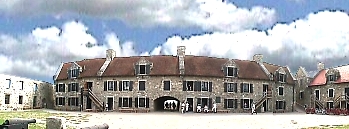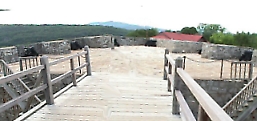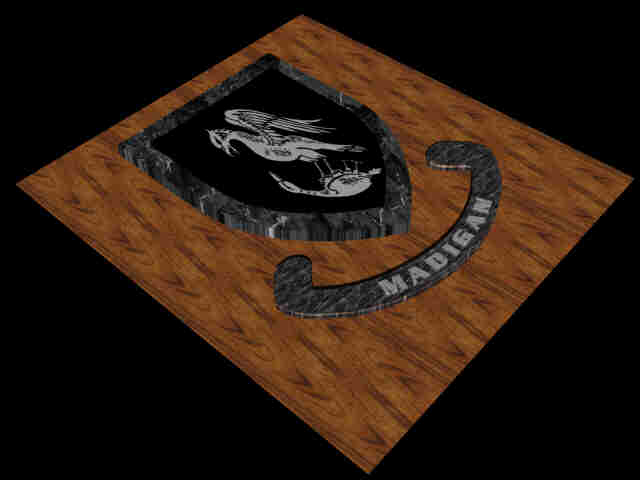Fort Ticonderoga
A Famous French Fort.
Ticonderoga, NY.
August 19th, 1999
I don 't want to
give away my age, but my first introduction to Fort Ticonderoga
was in the mid 50's as I sat in a small town movie theater
watching my first 3-D movie by the same name. From that point on,
the name has stayed with me as a place of wonderment. Now, I was
right there where it all happened. The Lake George area of New
York. After my initial disappointment at finding out that Fort
Ticonderoga was not in Vermont but actually in New York, by more than several hundred yards, I renewed my spirit and set out to
find the real history behind this childhood experience. In
setting the stage, please consider the year the Fort was built
was 1755. The British ruled the colonies and the French
maintained large land holdings north of New York, centering
around Montreal. The
't want to
give away my age, but my first introduction to Fort Ticonderoga
was in the mid 50's as I sat in a small town movie theater
watching my first 3-D movie by the same name. From that point on,
the name has stayed with me as a place of wonderment. Now, I was
right there where it all happened. The Lake George area of New
York. After my initial disappointment at finding out that Fort
Ticonderoga was not in Vermont but actually in New York, by more than several hundred yards, I renewed my spirit and set out to
find the real history behind this childhood experience. In
setting the stage, please consider the year the Fort was built
was 1755. The British ruled the colonies and the French
maintained large land holdings north of New York, centering
around Montreal. The  French desire to
control the Lakes brought them to a small area of land between
Lake Champlain and Lake George in New York. Native Americans
farmed these sandy meadows and fished and hunted in the rich
marshlands surrounding this peninsula. Iroquoia speakers called
this Ticonderoga "the place between the waters". In
1755 The Marquis de Vaudreuil, Governor of New France, ordered
the Canadian engineer Lotbiniere, to build a fort at
French desire to
control the Lakes brought them to a small area of land between
Lake Champlain and Lake George in New York. Native Americans
farmed these sandy meadows and fished and hunted in the rich
marshlands surrounding this peninsula. Iroquoia speakers called
this Ticonderoga "the place between the waters". In
1755 The Marquis de Vaudreuil, Governor of New France, ordered
the Canadian engineer Lotbiniere, to build a fort at  Carillon, as
they called it, to assure continued French control of the vital
thoroughfare. The French designed the Fort for a garrison of some
400 men sufficient for peace-time and for protection against
winter raids in war time. Thousands of soldiers came south from
Canada in the late spring and lived in tents outside the Fort.
When fall brought an end to large scale warfare, they went back
north into winter quarters and the little garrison held the Fort
and the road to Canada until the next spring. In 1758 A mighty
British army of 15,000 men attacked Carillon but were utterly
defeated by Montcalm's 3500 French and Canadian troops.
Carillon, as
they called it, to assure continued French control of the vital
thoroughfare. The French designed the Fort for a garrison of some
400 men sufficient for peace-time and for protection against
winter raids in war time. Thousands of soldiers came south from
Canada in the late spring and lived in tents outside the Fort.
When fall brought an end to large scale warfare, they went back
north into winter quarters and the little garrison held the Fort
and the road to Canada until the next spring. In 1758 A mighty
British army of 15,000 men attacked Carillon but were utterly
defeated by Montcalm's 3500 French and Canadian troops.  Again
in 1759 Gen. Amherst lead another British army against Carillon.
This time the France abandoned it. Amherst restored to the Fort
its Indian name, Ticonderoga. For
Again
in 1759 Gen. Amherst lead another British army against Carillon.
This time the France abandoned it. Amherst restored to the Fort
its Indian name, Ticonderoga. For  the next 16 years, a small British garrison
policed the increasingly violent frontier between New York and
New England and allowed the Fort to fall into ruin. With the
beginning of the Revolutionary War, early on a May morning in
1775, Ethan Allen, the Green Mountain Boys and Benedict Arnold
seized the Fort from its surprised defenders in the first
American victory of the Revolution. The Fort fell without a shot
fired, when a French picket's musket failed to fire and he was
overcome before he could sound the alarm. That winter, most of
the Fort's cannons were taken to Boston by Col. Henry Knox and
helped Washington's army drive the British from that city. The
American army strengthened fortifications but it was never
brought up to its original strength.
the next 16 years, a small British garrison
policed the increasingly violent frontier between New York and
New England and allowed the Fort to fall into ruin. With the
beginning of the Revolutionary War, early on a May morning in
1775, Ethan Allen, the Green Mountain Boys and Benedict Arnold
seized the Fort from its surprised defenders in the first
American victory of the Revolution. The Fort fell without a shot
fired, when a French picket's musket failed to fire and he was
overcome before he could sound the alarm. That winter, most of
the Fort's cannons were taken to Boston by Col. Henry Knox and
helped Washington's army drive the British from that city. The
American army strengthened fortifications but it was never
brought up to its original strength.
 <<<<< Back
<<<<< Back